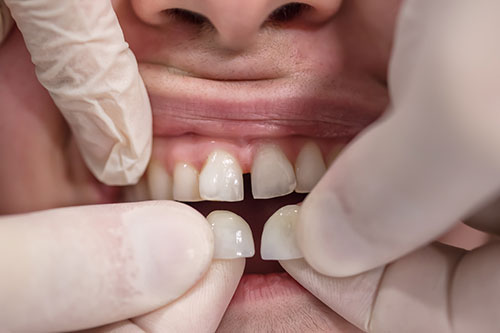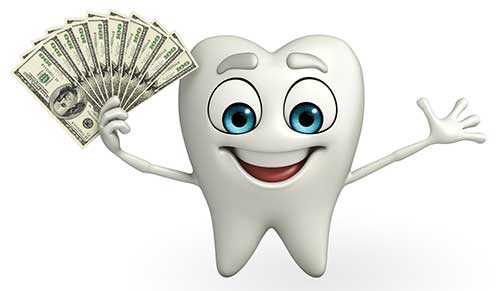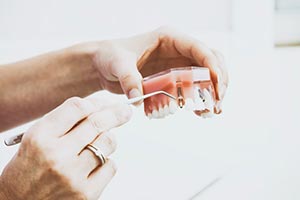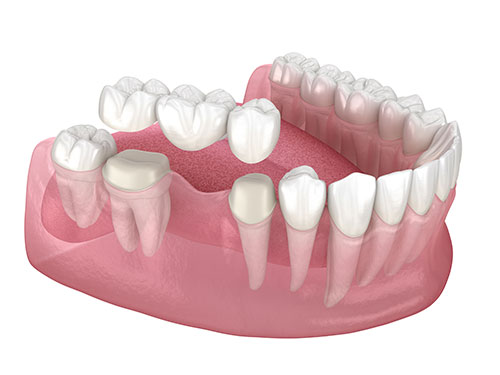Dental Implants – Replacing Teeth
 A statistic by the American College of Prosthodontics states that more than 120 million Americans miss at least one tooth, and 36 million Americans do not have any teeth. However, only 15% of the latter have dentures.
A statistic by the American College of Prosthodontics states that more than 120 million Americans miss at least one tooth, and 36 million Americans do not have any teeth. However, only 15% of the latter have dentures.
Loss of a tooth can lead to several problems down the road if you do not replace it in time. Missing teeth can affect the ability to chew your food, the ability to speak, and the integrity of the jaw bone. Fortunately, there are quite a few options to replace your teeth and restore the beautiful smile.
Our article walks you through the different tooth replacement options, costs, cheaper alternatives, and much more.
Options for Replacing Missing Tooth
No matter how you lost, a missing tooth can negatively impact the appearance and alignment if not replaced soon enough. Here are a few replacement options to help restore your smile:
- Dental Implants
Being the most common replacement option, dental implants are very reliable and feel similar to a natural tooth. They can also be permanent options not just for a single tooth but also for multiple teeth in different areas. However, they can also be expensive and is a long process.
- Implant-Supported Bridge
An implant-supported bridge is an excellent option if multiple teeth are missing in a row. Instead of having individual implants for every missing tooth, the teeth at both ends are implants and hold the rest in place without any screws. They are as effective as implants and also an economical option.
However, they are not a permanent option and will need to be replaced. Similar to implants, they are also a lengthy process.
- Tooth-Supported Bridge
Similar to an implant-supported bridge, the tooth-supported bridge uses the existing teeth to support the bridge rather than placing implants. The dentist places a crown on the healthy teeth next to the missing ones and cements them into place.
However, you run the risk of damaging the adjacent teeth if fitted poorly. When not cleaned properly, food particles can get under the bridge leading to decay and bone loss.
- Removable Partial Dentures
Removable partial dentures are a comparatively cheaper option than the above and replace the missing teeth. The partial dentures are fixed into position using metal clasps, ensuring that the false teeth do not fall out.
The disadvantage with removable partial dentures is that they have to be removed every night before sleeping and are not natural since the metal clasp is visible.
- Flipper
Flipper is a temporary partial denture that flips in and out of position. They are relatively cheap and a painless option. They also do not depend on the surrounding teeth.
On the other hand, they are bulky and can be uncomfortable.
Permanent Tooth Replacement Option
Dental implants are permanent tooth replacement options that look very much closer to natural teeth. American Association of Oral and Maxillofacial Surgeons (AAOMS) reports that dental implants are 95% effective. But people with risk of gum disease like diabetes may not be eligible for the procedure. Beyond the aesthetic factor with your smile, they help you carry on with your daily activities without any issues.
The procedure for dental implants starts with a titanium screw in the place of your tooth’s root. This acts as an anchor and holds the tooth in place. The implant is left to heal for several months when it fuses to your jaw bone. Once healed, your dentist places the crown on top.
Temporary Tooth Replacement
Flipper, otherwise called a temporary partial denture, is a removable denture that fits the roof of your mouth or to the lower jaw. It is made from acrylic dental-grade resin and doesn’t take long to prepare since all your dentist needs are impressions of your mouth which are then fabricated at a laboratory.
Flipper is less expensive and looks relatively natural. They are easy to wear but can cause discomfort, especially in the beginning. On the downside, people with flippers run the risk of developing gum disease and gum recession. Due to these reasons, they are usually a temporary replacement until the dental implant treatment is completed.
Cost for Replacing Missing Teeth
 There are quite a few treatments for missing tooth and in varying price ranges:
There are quite a few treatments for missing tooth and in varying price ranges:
Dental Implants: A surgical procedure that may cost anywhere between $3,000 – $6,000 for a single tooth. Generally, your insurance may cover the treatment, but you will be responsible for the deductibles and the co-pays.
Dental Bridge: A non-surgical option that costs from $3,000 – $5,000 for a single bridge. Again you may want to check with your insurance about coverage.
Removable Partial Denture: A removable option that can cost between $1,500 – $3,000.
Flipper – The least expensive partial denture costs anywhere from $300 to $500 for the front set of flipper tooth.
Full Teeth Replacement
 Due to recent technological advancement, a full teeth replacement is possible and is not as scary as before. Here are a few complete teeth replacement options:
Due to recent technological advancement, a full teeth replacement is possible and is not as scary as before. Here are a few complete teeth replacement options:
- Traditional Dentures
Traditional complete mouth dentures have a full set of prosthetic teeth in a gum-colored acrylic base. They are held in place with denture adhesive and need to be cleaned every day. While the initial cost is lower, the ongoing expenses make up for it since you need frequent replacements every two years or so.
Though implants fit better with modern advances in prosthetic dentistry, they only replace the crowns of the teeth and not the root leading to jawbone shrinkage. The dentures also make it difficult to eat hard and tough food. A complete set of dentures can cost as much as $2000.
- Implant-supported Dentures
Implant-supported dentures are similar to traditional dentures but are held together by implants and not adhesives. The most significant advantage is that they maintain the size and shape of the jaw. They also last as long as 15 years, contrary to the traditional ones. Moreover, they are stable and provide up to 100% chewing function like your natural teeth making it easy to eat all kinds of food.
The disadvantages are the time taken to complete the treatment and the up-front cost, which can be up to $5000.
Consequences of Not Replacing Missing Teeth
When it comes to tooth loss, the consequences are far-reaching beyond the appearance and much more than a cosmetic issue. Here are some of the health issues of missing teeth:
- Increased chances of infection: A tooth loss leaves the sides and the root of the adjacent teeth exposed, leading to more chances of infection. The empty dental socket acts as the entry point for the bacteria leading to bone loss and decay in the future.
- Gums and jawbone deterioration: Without the teeth, your body absorbs parts of the gums and bone, which accelerates the process of tooth fall. And it also changes the structure of the face leading to a facial collapse.
- Teeth misalignment: Teeth stay in alignment by exerting constant pressure on both sides. After a loss, the teeth on either side drift inward, causing misalignment.
Hence it is imperative that you replace missing teeth as soon as possible.
Cheap Missing Tooth Replacement Options
Dentures are the most affordable options to replace a missing tooth. It is non-invasive and takes less time to create (a matter of few weeks). They are more natural-looking and are easy to wear. On the downside, you cannot eat certain foods and lose the ability to experience the food thoroughly.
Another less expensive yet more secure replacement option is the implant-supported denture. Here the denture is held in position by a dental implant.
Dental Implants vs. Dentures & Bridges
Dental implants are the most natural-looking replacement option for missing teeth. However, it is a surgical procedure and takes several months to heal before placing the false teeth. It can last as long as 15 years with no health issues.
On the other hand, Bridges are less invasive but are fixed and have a lower cost than a dental implant. The downside is that they last just around 5-7 years.
The denture can either be removable partial dentures or a complete set of dentures. The former is held in place with clasps, and the latter is held by dental adhesive.
Benefits and Risks of Dental Implants
Though dental implants the best possible option to replace missing teeth, it is an invasive treatment and, as such, carries some risk. Here are the benefits and risks of dental implants.
 Benefits
Benefits
- Once the implant is set, it becomes natural, eliminating the discomfort associated with a denture.
- A dental implant gives your smile back and elevates your confidence.
- Since it doesn’t require support from adjacent teeth, it improves overall oral health and hygiene.
- Implants are durable and last a long time with proper care.
 Risks
Risks
- If your jawbone cannot support an implant, your dentist will restore it with a bone graft.
- Never damage due to surgery can lead to numbness and tingling.
- Upper implants can lead to issues with the sinus cavity.
- The implant has a longer treatment time and will require a great number of dental visits.
Cost of Dental Implants
The average cost of a single tooth dental implant can be between $1000 to $4000, depending on your oral health and needs. The cost of the procedure alone can go as much as $6000 and includes:
- Crown
- Abutment
- Implant
- Tooth extraction
- Bone Graft
This is a wide range and may change depending on the individual person.
Do Dental Implants Feel Natural?
A dental implant doesn’t have a root hence cannot process sensations such as heat, cold, etc. Other than that, it feels natural much more than any other dental treatment. Furthermore, dentists mold and shape the crowns to match the natural tooth appearance-wise.
Alternatives for Dental Implants
 The most common alternative to dental implants is the tooth-supported fixed bridge. Fixed bridges involve grinding the healthy adjacent teeth to attach the bridge. Since the bridge provides just the crowns, the bone beneath may worsen over time. Also, they can last as much as five years before failing.
The most common alternative to dental implants is the tooth-supported fixed bridge. Fixed bridges involve grinding the healthy adjacent teeth to attach the bridge. Since the bridge provides just the crowns, the bone beneath may worsen over time. Also, they can last as much as five years before failing.
Conclusion
A tooth loss should be taken seriously as it has cascading effects on oral health. A tooth replacement is the only way to minimize the impact. A dental implant, denture, partial denture, dental bridge, tooth-supported bridge, and flipper are some options for replacing missing teeth.
If cost isn’t an issue, an implant is the better tooth replacement option since it doesn’t affect or damage the adjacent teeth. However, you may want to consult with your dentist to choose an option that best suits your situation.
One of the best dentists in the Tucson area is Dr. Dalesandro, who has the experience you want to help you with your dental problems; call today for your next appointment.
